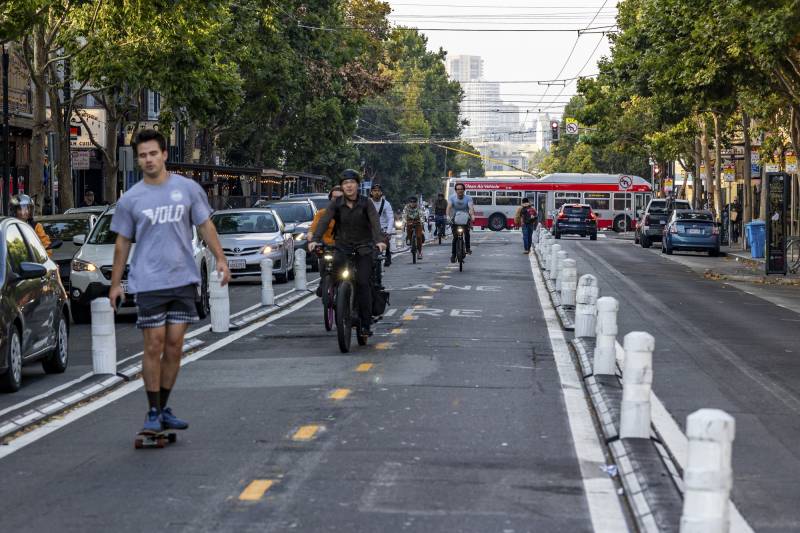The report shows that bike traffic along Valencia Street declined by as much as 53% in September compared to the previous October. It also shows a significant drop in daily motor vehicle volume, as much as a 42% decline, especially in the northern portion of the corridor. Peak pedestrian volumes also declined as much as 42% in some locations, with an overall 18% decline.
In a press release Thursday, SFMTA said the draft report “only accounts for a small portion of our evaluation period during which cyclists were returning to Valencia Street after the pilot construction period.”
The agency says it is finalizing a three-month evaluation report and added that it estimates average daily bike volume is about 3% higher than before the pilot began. The agency says the September drop in drivers, cyclists and pedestrians seen in the draft report was due to cyclists slowly returning to the street after the bike lane was completed. Construction began in mid-April, but the center-running bikeway didn’t open until Aug. 1.
When the draft report was first released Wednesday, opponents of the Mid-Valencia Pilot say the decline in bike traffic shows the pilot is failing to achieve its goals.
The data was reportedly obtained through an anonymous public records request and released by Luke Bornheimer, an independent safe streets advocate and a leading critic of the bike lane.
“This unprecedented decrease in people biking on Valencia Street should be a wake-up call to Mayor Breed and the SFMTA Board of Directors,” Bornheimer says in a press release.
Improving traffic safety was also a major priority of the pilot. Valencia Street is on the city’s high-injury network. Three pedestrians have been struck and killed on Valencia Street since 2020. One, 80-year-old Jian Huang of San Francisco, was struck and killed last September by a driver who was turning left onto Valencia.
Some aspects of the draft report show the pilot was achieving some of the SFMTA’s goals.
The report shows a steep decrease in vehicles double-parking and loading in the bike lane, one of the project’s major goals. Before the pilot, people working for ride-hailing apps and app-based delivery services would often double-park in the existing bike lane, forcing cyclists to make a dangerous merge into the vehicle lane. In instituting the pilot, SFMTA says it’s tried to walk a line between improving traffic safety and preserving business access.
But a growing chorus of business owners on Valencia Street have complained that the pilot has led to a steep drop in sales.
The live music venue Amado’s, which had been in operation for eight years at 21st and Valencia, closed in November and blamed the pilot for an 80% drop in revenue. As part of the pilot, SFMTA eliminated 71 metered parking spots and converted them into loading zones.
“It became completely untenable for artists, staff trying to find parking, and mainly, any kind of customer that would like to come and enjoy our venue,” says Amado’s owner, David Quinby, in an interview.
